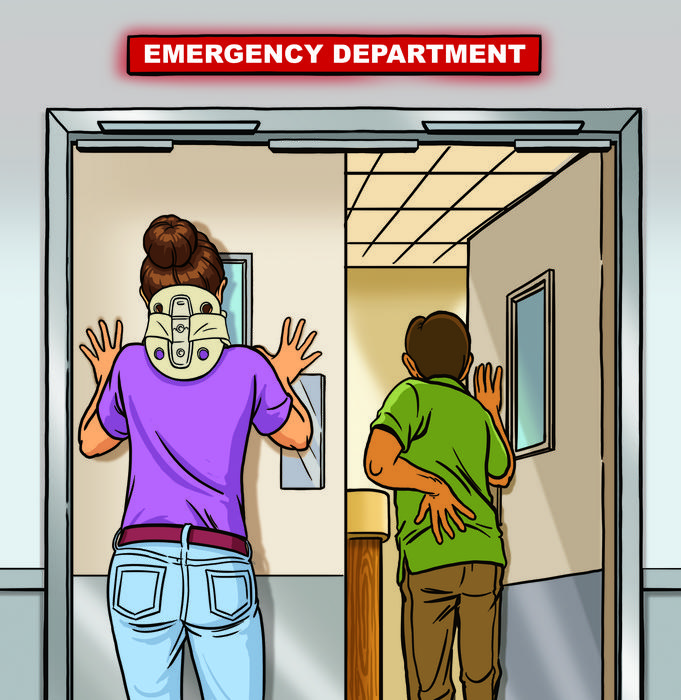New study reveals a significant sex bias in pain management at emergency departments, showing that female patients are consistently less likely to receive pain medication prescriptions compared to male patients with similar complaints. This bias persists across different ages, pain levels, and physician sex, indicating a systemic issue. Female patients’ pain scores are less frequently recorded, and they spend more time in the emergency department than male patients. The findings highlight the need for urgent policy interventions and training for healthcare professionals to address and counteract these biases, ensuring equal pain treatment for all patients.

Credit: Avi Blyer
New study reveals a significant sex bias in pain management at emergency departments, showing that female patients are consistently less likely to receive pain medication prescriptions compared to male patients with similar complaints. This bias persists across different ages, pain levels, and physician sex, indicating a systemic issue. Female patients’ pain scores are less frequently recorded, and they spend more time in the emergency department than male patients. The findings highlight the need for urgent policy interventions and training for healthcare professionals to address and counteract these biases, ensuring equal pain treatment for all patients.
A new study led by Prof. Shoham Choshen-Hillel and Mika Guzikevits from the Hebrew University, Dr. Alex Gileles-Hillel from Hebrew University- Hadassah Medical Center, Dr. Tom Gordon-Hecker from Ben-Gurion University, and an international team of researchers from Hebrew University, Hadassah Medical Center, the University of Missouri, and Marshall University has uncovered a concerning sex bias in pain management decisions at emergency rooms. The research, published in the journal PNAS, analyzed over 21,000 patient records across the United States and Israel and found that female patients are consistently less likely to receive pain medication prescriptions compared to male patients with similar complaints.
The study revealed that female patients are prescribed fewer pain relief medications than male patients, even after considering the levels of pain reported and other variables such as age, medical history, and the type of complaint. This suggests a systemic issue where women’s pain may not be taken as seriously or treated as aggressively as men’s pain.
By analyzing electronic health records from American and Israeli healthcare systems, the researchers present evidence that a female patient discharged from the emergency department is less likely to receive treatment for a pain complaint compared to a male patient. Specifically, datasets from emergency departments in the US and Israel, with a total sample size of 21,851 discharge notes, revealed that female patients are less likely to receive a prescription for any type of analgesic medication, both opioids and non-opioids, compared to male patients.
Female patients with pain complaints are less likely to receive analgesics for every pain score and at every age group and receive less analgesics from both male and female physicians. In addition, female patients stay an additional 30 minutes at the emergency department, and their pain score is 10% less likely to be recorded by triage nurses. In a controlled experiment involving 109 nurses, pain was rated as less intense if the patient was said to be female rather than male, suggesting that the bias is driven by gender stereotypes. According to the authors, the under-treatment of females’ pain bears immediate implications for the healthcare system and broad implications for society’s attitude toward female pain.
Interestingly, the study found that this disparity in prescribing pain medication exists regardless of whether the treating physician is male or female. Both male and female doctors are less likely to prescribe pain medication to women, indicating that the bias is pervasive and not limited to one sex of healthcare providers.
The research also highlighted that nurses are 10% less likely to record pain scores for female patients compared to male patients. This lack of documentation can contribute to underestimating the severity of women’s pain and result in inadequate treatment. Additionally, the study found that female patients spend an average of 30 minutes longer in the emergency department than male patients. This delay could be due to a variety of factors, including potentially being taken less seriously when they report pain or symptoms.
In a controlled experiment, nurses judged female patients’ pain as less intense than male patients’ pain when presented with identical clinical scenarios. This suggests that there may be a subconscious bias in how healthcare professionals perceive and assess pain based on the patient’s sex..
“Our research reveals a troubling bias in how women’s pain is perceived and treated in emergency care settings,” said Prof. Choshen-Hillel. “This under-treatment of female patients’ pain could have serious implications for women’s health outcomes, potentially leading to longer recovery times, complications, or chronic pain conditions.”
Recommendations: The study argues that these findings reflect a systemic under-treatment of women’s pain in medical settings. The researchers call for urgent policy interventions to address this bias and ensure equal pain treatment regardless of sex. They recommend training programs for healthcare professionals to recognize and counteract sex biases and suggest that pain management protocols should be revisited and standardized to ensure fair and adequate treatment for all patients.
Journal
Proceedings of the National Academy of Sciences
DOI
10.1073/pnas.2401331121
Method of Research
Data/statistical analysis
Subject of Research
People
Article Title
Sex Bias in Pain Management Decisions
Article Publication Date
5-Aug-2024




